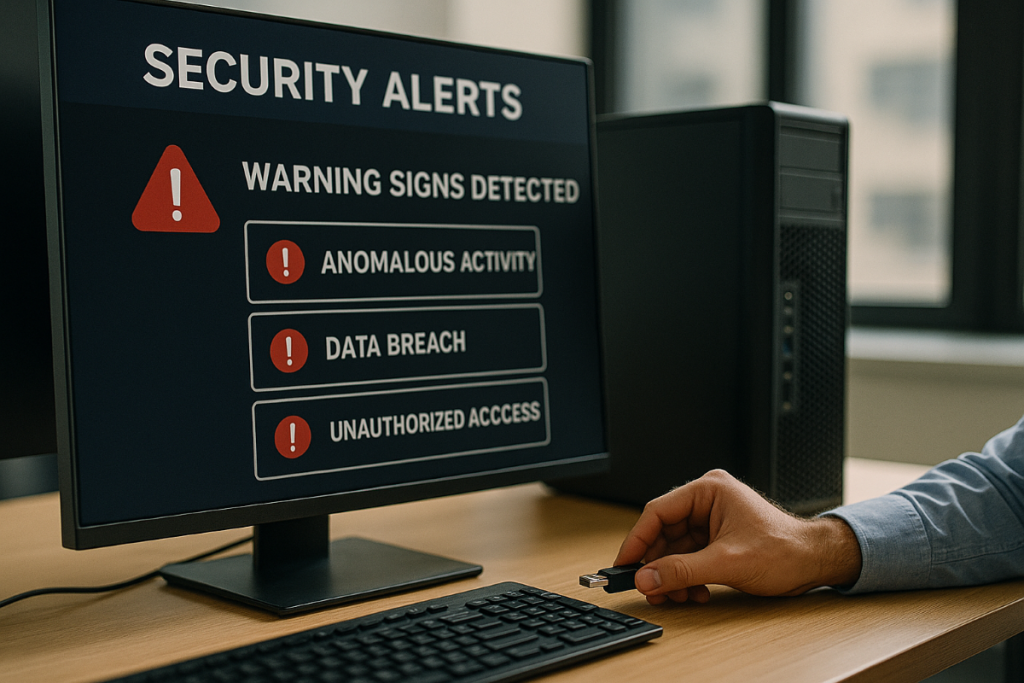| Jun 10, 2025
The Insider Threat Red Flags Are There – Are You Watching?

By the time someone hits “send” on a stolen file or walks out with a hard drive, it’s too late.
Most insider security incidents don’t come out of nowhere. The warning signs are there – you just have to know what to look for. The problem? Most organizations aren’t watching for these security threats. Or worse… they’re watching for the wrong things.
This is Part 3 of our ongoing Insider Threat series, where we are digging into the human side of internal risk and organizational security vulnerabilities. In this blog, we’ll breaking down the behavioral red flags that tend to show up before and insider security threat ever makes a move – and why ignoring them can be a recipe for disaster.
It Doesn’t Start with the Security Breach
Contrary to what Hollywood would have you believe, insider security incidents rarely start with a “heist.” They start with behavior – shifts in mood, attitude, routine, access patterns. If you’re only watching for technical indicators, you’re missing the earlier, more human signs of a potential security problem.
According to the Cybersecurity & Infrastructure Security Agency (CISA) Insider Threat Mitigation Guide, most insider threats exhibit a mix of personal, professional, and digital indicators long before a security breach occurs.
That includes things like:
- Sudden or extreme changes in demeanor.
- Declining work performance or increased absenteeism.
- Unusual interest in data outside of their professional scope.
- Complaints of being undervalued, overlooked, or mistreated.
- Attempts to access systems or information not relevant to their role.
Patterns of Risk, Not One-Off Security Incidents
No single behavior automatically makes someone a threat. But patterns of behavior – especially when stress, access, and resentment overlap – can turn into a serious security risk.
The folks at DTEX Systems put it well in their 2024 Insider Risk Report: “Every insider incident is preceded by a pattern of behavioral indicators – ignored not because they were invisible, but because no one was empowered to connect the dots.”
What Should You Be Looking For When it Comes to Insider Threats?
Here are some high-frequency red flags we see again and again during assessments, audits, and post-incident investigations:
Personal & Psychological Indicators:
- Mood swings, agitation, or signs of burnout.
- Open discussions about financial hardship, personal crisis, or “checking out.”
- Growing frustration with leadership, culture, or workload.
Behavioral & Workplace Shifts:
- Sudden drop in performance or involvement.
- Withdrawal from team collaboration or communication.
- Breaches in protocol followed by excuses or defensiveness.
Access & Technical Behavior:
- Accessing files outside of working hours or from unusual locations.
- Downloading large volumes of data without a clear business need.
- Using unauthorized storage devices or personal email accounts.
Not all of these are malicious. But left unchecked, they compound – and that’s when things can break.
What You Can Do Right Now to Protect Your Organization
If your only insider threat strategy is logging network activity and hoping for the best, you’re reacting – not protecting.
Here’s what works:
- Cross-functional communications between security, Human Resources (HR), legal, and Information Technologies (IT).
- Clear protocols for reporting and escalating behavioral concerns.
- Training your teams on what to look for – beyond just phishing emails.
- Bringing in outside eyes to run an intelligence-led assessment before a potential security problem becomes a real one.
At Convoy Group, we work with leadership teams to move from blind spots to foresight. We don’t just help you respond to insider threats – we help you spot the smoke before there’s a fire.
Coming Up Next
In Part 4 of this Insider Threat series, we’re going to walk through real-world case studies – what went wrong, what was missed, and how it could have been avoided.
Want to know if red flags are being missed inside your organization?
Let’s talk before they turn into headlines:
